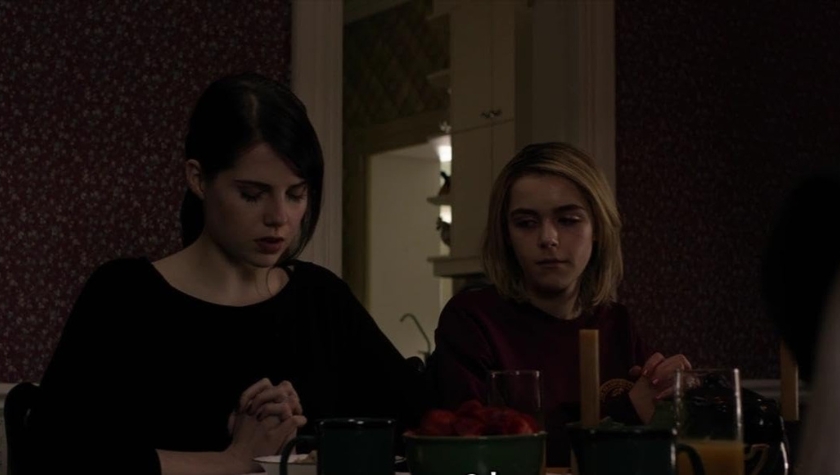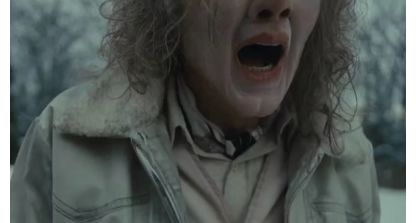Osgood Perkins has become one of the leading names in modern horror movies in the decade since his debut film, The Blackcoat’s Daughter (2015). The writer and director arrived with a distinct aesthetic which he’s continued to expand, exploring themes around the unknowability of loved ones and the depths of grief through slow creeping dread and artful composition. With the back to back hits of Longlegs (2024) and The Monkey (2025), Perkins joined the ranks of name brand directors of big screen terror, but his films contain a deeply personal depth that goes beyond the scares.
Perkins is the son of Anthony Perkins, a horror acting legend in his own right from playing Norman Bates in the Psycho film series, and who died from AIDs related pneumonia in 1992. His photographer/actress mother, Berry Berenson, died while aboard the plane that hit the North Tower of the World Trade Center on September 11th, 2001. Perkins no doubt has cinema in his blood, but the senselessness of these tragic losses also formed a thematic foundation for his films.
After a period of acting in various supporting roles, Perkins finally found his way behind the camera at the age of 40, and began mining the complicated feelings around his personal tragedies in ways both scary, and sometimes humorous. The universality of this cinematic exploration has become undeniable as evidenced by the legion of fans building anticipation for his new film, Keeper (2025). And though it’s one of the few films for which he didn’t write the script, Perkins’ visual style and thematic interests are as evident as ever. Here are the 6 films of writer/director Osgood Perkins.
THE BLACKCOAT’S DAUGHTER (2015)
Perkins wanted to write and direct films since he was a child, but could never seem to break in, even finding his way into acting while navigating the industry. He started receiving credits behind the camera as a co-writer on the small genre films, Removal (2010) and Cold Comes The Night (2013), before feeling like he was ready to make his own project. As a starting point, he emulated favorite films that he wished he’d made, namely dark domestic horror films with unresolved mysteries at their core, like Don’t Look Now (1973) and The Shining (1980), and channeled his reckoning with grief into a script for The Blackcoat’s Daughter (2015).
The film intercuts two narratives, one in which Kiernan Shipka plays a teenager descending into what could either be demonic possession or psychosis at a largely empty Catholic boarding school during winter break, and one in which Emma Roberts plays a wanderer with a mysterious past. The stories interact and resolve in violent and bone-chilling ways in the confident hands of a filmmaker arriving with a singular voice and brimming with grief.
Studio representatives loved the script, but admitted that they would never be able to make it, but with pieced together independent financing, Perkins managed to mount the production in Canada and the film premiered at the Toronto International Film Festival. Though it received a positive reception, Blackcoat didn’t get a proper theatrical release until 2017, after Perkins had already made his second film for Netflix.


I AM THE PRETTY THING THAT LIVES IN THE HOUSE (2016)
For his sophomore feature, Perkins wrote another deeply personal horror film, the supernatural gothic tale, I Am The Pretty Thing That Lives In The House (2016). He based the premise on a desire to better know his father after he lost him at the young age of 18. In the narrative, it’s a live-in nurse played by Ruth Wilson who’s trying to better understand the dementia-stricken, Shirley Jackson-esque writer she’s caring for, played by Perkins’ family friend, Paula Prentiss.
The personal connections continue with the film’s setting, a home based on a 1790s Cape Cod house that Perkins’ father purchased for the family. As Wilson’s character becomes increasingly obsessed with her unknowable employer, it becomes clear that the house is haunted, and the dark secrets behind the haunting lie somewhere in the pages of her books. Under the gothic atmosphere and eerily unfolding ghost story, one can feel the yearning of the film’s author trying to connect with a father he never had a chance to fully get to know.
Perkins found financing at Netflix during a period when the streamer was taking bold risks on original films. With a worldwide streaming debut just in time for Halloween and A24 gearing up for a theatrical release of Blackcoat, Perkins was becoming a horror voice to watch. For his next project he turned to a centuries old horror tale to grapple with the personal once more.
GRETEL & HANSEL (2020)
The Brothers Grimm published the German folktale of “Hansel and Gretel” in their Grimms’ Fairy Tales collection in 1812, and the story has seen many permutations across media in the centuries since. When the script for screenwriter Rob Hayes’ interpretation, Gretel & Hansel (2020), came to Perkins, he appreciated the uncomplicated simplicity of the adaptation and was excited to put his own directorial mark on an existing story. Gretel, as played by Sophia Lillis, is older than Hansel in the film, and takes center stage while squaring off with the witch whose woodland hut they seek shelter in.
Perkins opted to shoot the film in a more square 1.55:1 aspect ratio on location in Ireland, giving it a painterly, dark and foggy visual style. When it hit theaters just before the Covid-19 shutdown in 2020, it became a small hit, quadrupling its meager budget. The film sees Perkins deepening his visual style and control of tone, evolving his directorial skillset in ways that would strengthen his self-written projects as well.
Years later, Perkins admitted that he felt he’d missed the opportunity to inject a thematic angle into the film about a mother’s ability to deceive a child out of love in order to protect them. The theme goes back to Perkins’ experience of his mother attempting to keep his father’s private life a secret from her children. While the subject didn’t make its way into Gretel, it became the center of Perkins’ next original movie, and his first gigantic hit.


LONGLEGS (2024)
Perkins has often described the starting point of his scripts like a crossword puzzle, where you figure out the first answer across and then slowly work from there. The starting point for Longlegs (2024) was an interest in the serial killer mystery films of the 90s like The Silence of the Lambs (1991) and Seven (1995), which left an impression on him as a teenager. He used their reliable formula as a starting point from which to take a hard left turn into horror, exploring the aforementioned themes of deadly secrets kept by a mother from her daughter out of love.
In this case, Alicia Witt plays the disturbed mother of the protagonist, an FBI agent played by Maika Monroe, who uncovers dark family secrets while investigating the titular serial killer, as played unforgettably in an androgynous, glam rock-inspired turn by Nicolas Cage. Neon launched a viral, guerilla marketing campaign similar to the successful marketing of The Blair Witch Project (1999), using creepy online imagery and mysterious phone numbers, and concealing the look of Cage’s Longlegs character to build anticipation. The efforts paid off, and Longlegs became a big hit, grossing $128m worldwide off of its $10m budget.
As Perkins predicted, by using a familiar hook in the serial killer investigation genre, he was able to bring in a mass audience for another personal horror story. Without compromising his voice and style, Perkins finally had a smash hit, and he already had his next two films in the can.
THE MONKEY (2025)
James Wan’s production company, Atomic Monster, acquired the rights to Stephen King’s 1980 short story, The Monkey, after many other attempts at adapting it failed to get on screen. Wan brought it to Perkins, and given the subject matter of a toy monkey who causes people around it to die, Perkins saw a vehicle for exploring his familiar theme of the absurdity of death in more comedic terms. The project was ready to go in early 2023, but got delayed by the labor strikes and ultimately went before cameras a year later.
Theo James plays twin brothers driven apart by the curse of the toy monkey, who seems to doom everyone they love to brutal deaths. Perkins delights in his gory, Rube Goldberg-esque killings, favoring cartoonish laughs over genuine horror. Neon handled distribution after the success of Longlegs, and The Monkey (2025) became another hit, just seven months later.
But The Monkey wouldn’t be the only Osgood Perkins film of 2025. Feeling antsy and creative during the labor strikes, Perkins reassembled members of his Longlegs crew to mount a low budget production that would become his third movie in under 2 years.


KEEPER (2025)
Perkin’s latest film is Keeper starring Tatiana Maslany, who also plays the ill-fated mother in The Monkey, as one half of a couple who go to a romantic getaway in the woods, only to encounter sinister supernatural forces. Neon is following its Longlegs playbook, keeping the plot tightly under wraps, but the terrifying imagery of the trailer, which includes quotes from horror icons like Wan and Guillermo Del Toro, suggest Perkins’ scariest movie yet.
Keeper punctuates a creative cycle that saw Perkins cross over into the mainstream of horror filmmaking through a trilogy of films that feel as if they poured out of him. And he shows no signs of slowing down. Through his continued partnership with Neon, he’s returning to Canada to direct his first original script since Longlegs, the Nicole Kidman-starring The Young People. The anticipation of Keeper and its starry follow-up highlight one of those rare and exciting periods where a singular filmmaker is on a roll, and through it all, Perkins has maintained his distinct voice and personal curiosities. By taking the legacy of his family and the terror of his personal tragedies, and pouring them into the type of film that he most wanted to see, Perkins developed a successful style of genre storytelling that’s all his own.

